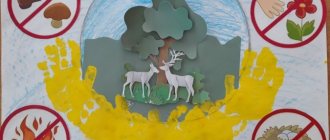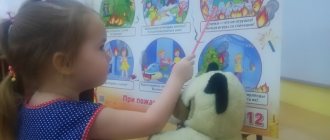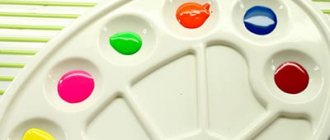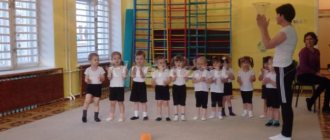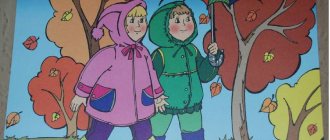Junior group. Early childhood, nursery. Children 1-4 years old
Summary of a lesson on artistic creativity for children 3–4 years old “Autumn Tree” Picture blank Objectives: – development of children’s productive activities (drawing, appliqué, artistic design and labor ); – development of children's creativity; - introduction to fine arts. - develop interest, attention, curiosity, emotional response...
Summary of a lesson on sensory in an early age group “Autumn has come to visit us” Summary of direct educational activities on sensory in an early age group Topic: “ Autumn has come to visit us”
. Goal: creating conditions for the development of sensory abilities in children. Objectives: Strengthen the ability to name the color of objects, select objects by color….
Summary of a lesson on familiarization with the environment in the 2nd junior group “Golden Autumn”
(I ask the child to bring pictures, and together we paste them on a large sheet of paper)
(I am attaching images of trees - in bloom, with fruits and without leaves)
- Well done. What trees are there in autumn? (Naked)
Where did their leaves go? (Fell, leaves are falling). What kind of leaves do trees have in autumn? (Beautiful reds and yellows)
Look, what kind of picture do we need?
(I ask the child to bring a picture, we paste it)
“Now let’s imagine that you are no longer children, but autumn leaves.” A light breeze blew, the leaves rustled, they smiled, they rustled happily with each other. And suddenly a strong wind blew and the leaves flew away. They fly easily, beautifully, the breeze plays with them. The leaves are spinning, having fun, dancing their dance, and suddenly they touch the ground and quietly - quietly lie down on the ground.
— Did you like being leaves? (Yes, I liked it). And now you are no longer leaves, but guys again, sit down on the chairs.
(children sit on chairs)
(I attach pictures of birds to the board)
- Guys, there were a lot of birds in the summer, where have they gone now? (Fly away to warmer climes)
- That's right, they flew to warmer climes, to the south. They will be warm there. Look, what kind of bird are we going to stick on?
(I call the child, choose a picture, stick it on)
- Well done. Tell me, have all the birds flown away? (No, not all)
That's right, some birds remain, and we will feed them in the cold weather. Let's find a picture with such a bird and paste it on.
(I call the child and stick together the desired picture)
(attaching pictures of animals)
— Do animals also run away to warmer regions in the fall? (No, they are preparing for winter).
How do they prepare for winter? (The squirrel collects mushrooms and pine cones, the hare changes its gray coat to a white, warm one)
That's right, well done.
(I call the children one by one and paste the selected pictures)
(I am attaching images of children dressed for different seasons)
— Guys, birds fly away in the fall, animals prepare for winter, insulate their holes. How do people escape the cold? (Dress warmly).
What are they wearing? (Warm clothes - jacket, trousers, sweater, hat, mittens, scarf, for feet - shoes or boots)
Look at our guys, which of them do you think we will send out for a walk in the fall?
(select a picture and paste it on a piece of paper)
- What great fellows we are. Now let's look at our picture, do you like it? (Yes, I like it).
What is it about? (children list things about autumn, leaf fall, rain). That's right, it's about autumn. So the first leaf from our book is ready. Do you think the sun will like our picture? (Yes, you will like it).
Summary of OOD in the junior group with presentation. Journey to the autumn forest
Summary of organized educational activities in junior group II
Topic: “Journey to the autumn forest”
Priority educational area • “Cognitive development” Integration of educational areas • “Socio-communicative development” • “Speech development” • “Artistic and aesthetic development” Goal: To consolidate ideas about autumn, about the signs and signs of autumn . Objectives: Educational:
1. Teach carefully, listen to the teacher’s speech, expand and activate the pupils’ vocabulary (“autumn”, “season”, “rustles”);
2. Improve the grammatical structure of speech; 3. Formation of elementary ecological ideas in children. Developmental:
1. Develop interest in the world around us during the game-travel;
2. Expand basic understanding of changes in nature in autumn, wild animals, and their lives. Educational:
1. Foster a caring attitude towards animals, love and respect for nature.
Objectives for educational areas in integration • Educational activity “Cognitive development”:
1. Enrich children’s sensory experience, develop imaginative ideas, by consolidating children’s knowledge about seasonal changes (autumn).
2. Expand ideas about wild animals living in the forest, learn to reflect received impressions in speech and productive activities. 3. To consolidate knowledge about the rules of behavior in nature, to cultivate children’s respectful attitude towards nature and animals. • Educational activity “Speech development”: 1. Develop children’s proactive, choral speech, enrich and clarify children’s ideas about the seasonal change of autumn. 2. Expand and activate children’s vocabulary 3. Create a need to share their impressions with people around them. • Educational area “Artistic and aesthetic development”:
1. Improve the technique of drawing with a ball of paper to depict autumn leaves.
2. Cultivate an interest in reflecting one’s impressions and ideas about nature, through the ability to create an artistic image. 3. Cultivate accuracy and independence • Educational area “Social and communicative development”:
1. Develop social skills: the ability to work in a group, take into account the opinion of a partner.
Types of children's activities Cognitive, communicative, playful. Methodical techniques 1. Organizational moment: The appearance of the fairy-tale Gnome. 2. Children’s answers to the teacher’s questions. 3. Choral reading of a poem with children. 4. Watch the video. 5. Conversation with children after watching the video. 6. Musical and rhythmic composition “Leaf, leaf-falling leaf”. 7. Didactic game: “Match by color.” 8. Productive activity “Golden Leaves” 9. Analysis of children’s activities, summing up. Planned results Shows a steady interest in various types of children's activities: play-traveling, listening and discussion, artistic creativity. Emotionally responds to the main character - the Gnome. Elementarily oriented in the space of the group. Actively participates in productive activities. Knows the sequence of movements of the music and dance composition “Leaf, leaf, leaf fall.” Materials and equipment • multimedia projector, screen • laptop • computer presentation • tree model • multi-colored autumn leaves made of paper • gouache • sheets of paper • wet hypoallergenic wipes for children • basket with gifts for children (nuts)
Progress of organized educational activities
Educator: Children, listen, who's rustling there? You hear?
Oh, yes, this is a gnome, a forest man. Let's say hello to the gnome. Gnome: Hello guys. Educator: What kind of gnome? (small). What do you think the gnome is in a mood for? (good) Of course, it’s good, the gnome smiles at us, let’s smile at him too. Educator: Look, the gnome brought us something, what is it? (leaves) What leaves? (beautiful, colorful, red, yellow, green). At what time of year are there colorful leaves? (in autumn) So what kind of leaves? (autumn) That's right, kids, these are autumn leaves. They are all multi-colored and golden, which is why they say about autumn: “Golden Autumn.” Educator: Let’s, guys, tell the Dwarf a poem about autumn: “Golden autumn walks along the paths. She has yellow boots on her feet. She has colored leaves on her dress, and in her basket there are wild mushrooms!” Gnome: Thank you guys, I liked your poem. I also really love this beautiful time of year. Do you want to visit the autumn forest? Educator: To get into the fairytale forest, you need to close your eyes and say the magic words: “I’ll slam, I’ll stomp, I’ll turn around. And I’ll immediately find myself in the forest.” Children, open your eyes, look how beautiful it is. (autumn forest on the screen). Educator: Let's sit down quietly and see what happens in the fall. (Video show)
Educator: Guys, what did you see? What are the trees like in autumn? (colorful, beautiful). What kind of animals do you think live in the forest? (list) In a word, what can you call them, what kind of animals? (wild). Smart girls, why are they called wild? (because wild animals get their own food, people don’t help them) Guys, what do animals do in the fall? (preparing for winter). How do you think one should behave in the forest? (quietly, don’t make noise, don’t shout, so as not to scare the animals). Let's take a walk in the forest with you. “Leaves are falling, leaves are falling, yellow leaves are flying, multi-colored leaves are rustling under the children’s feet.” (sound - rustling of leaves). Educator: Oh guys, look, the breeze blew and scattered all our leaves, let’s try to collect them by color. D/I “By color” Children complete the task.
Well done guys, collected all the leaves. Beautiful, carved, let's dance with them. (Dance with leaves - Leaf, leaf fall).
Educator: It felt good in the forest, quiet, calm. But soon all the leaves will fall from the trees, and we won’t see the trees so beautiful for a long time. Let's decorate this tree as a souvenir of autumn and give it to our gnome. We have a tree already drawn on our tables, let’s arrange leaf fall and draw leaves. But today we will draw not with brushes, not with pencils, but with crumpled paper. To do this, take a sheet of paper, crumple it so that you get a paper ball (the teacher accompanies his words with actions),
then dip a paper lump into yellow paint. We draw leaves by dipping paper.
Well done boys. The leaf fall turned out to be very beautiful.
Gnome: For your wonderful work, beautiful leaf fall, I want to give you a basket of gifts. Educator: Well, our journey has come to an end. Guys, did you like it in the forest? Who did we meet? What did we see in the forest? Educator: Children, let's say “Thank you” to our wizard gnome for the gifts and such a wonderful trip! But it’s time for us to say goodbye and return to kindergarten. Dwarf: Goodbye guys! Educator: Turn around and you’ll find yourself in kindergarten again. This is where our journey ended... “Thank you everyone for your attention, we say - goodbye!”
Presentation on the topic: Journey to the autumn forest
We recommend watching:
Summary of a lesson on speech development for the 2nd junior group. Pleshcheev “Autumn” Abstract of educational activities (application) for young children Abstract of educational activities on modeling for children of the 1st junior group of educational activities in the 2nd junior group. My family
Similar articles:
Lesson notes for the younger group. Broken applique “Autumn leaves”
